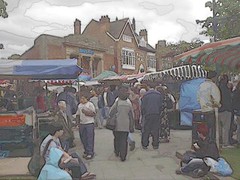Groovy Moseley Farmer's Market

Guaranteed 100% Moseley content - except for that which isn't. Ye live in a place, see stuff, do things, have a dialogue with yourself and sometimes others.
After a while it begins to resonate, things strike a chord, and comments start happening.
It's all just a reaction.
Moseley content, Moseley web-presence, things as yet undiscovered.
Here's where I change tune somewhat on the statue. There's more to the story than the headlines, as it were, and, as I said below, there are some good things about the proposal. This is where they get a bit of air and light.
Some details are now online at the Moseley Statue Group website. There's a history page with key dates and a sentence or so by way of explanation. There's also an important but equally brief three-sentence statement about the nature of the scheme. There's some reading between the lines to be done at this point. The statue is being developed as a gift. Why? Part of the answer is in the following sentence: 'There has been talk for years and a lot of money spent on consultation that has not resulted in any progress'. Frustration, matched with some initiative. Somebody wants somethign to happen, and if they have to buy their own statue, they'll do it. Good. Add that to the list of things to like about this scheme.
The unfailingly polite Mark Guest spent a few minutes with me going over the history of the scheme, which is more than I got by attending the last public meeting about it. What I discovered this time is that this is the sole offer as regards statuary. If this gets rejected, there's no latitude for tweaking it a bit and refining it in response to criticisms. In a way, it makes consultation pointless by reducing it to a simple vote on any given option. At this point, the vote is whether to go ahead with the proposal as is, or drop the whole thing. That goes against the grain of consultation as a means of fine-tuning, a way of picking up suggestions, criticisms, and other means of adjustment. I understand the constraints on the group, who sound like they're working unassisted, but it only underscores the argument that there should be more support coming from relevant agencies. Support as in making sure that decision-making resources are available to communities. Expertise, facilitation, research. Arts Council, hello? Or I am picking the wrong target again? Maybe this is where B:CEN could be advising.
The yes/no approach seems unusual in that a lot of public art goes through several iterations of design and feedback before being produced. That said, apparently this scheme has been going through iterations for some time now. Mark mentioned something about Hobbit Gates - which is not a scheme I've seen mentioned anywhere - and that it was rejected in favour of the tree sculpture. So the group have managed to get this far on their own, without the kind of institutional support that similar schemes elsewhere have had.
That's a drag, because there are good ideas behind some of this, and I would like to see them refined and developed. But we are left with a simple choice: yes or no to the scheme as it stands.
That's one part of the background. Another is that the way it developed is partly a response to attitudes of funding bodies. Who would they normally be? The city council? The Arts Council? Regeneration agencies? Bluntly put, there seems to be a certain amount of foot-dragging or outright resistance to the project on the part of organisations that should be facilitating its development. The example Mark gave is that when approaching council officers about what the statue could be made of, they were told that various materials were unacceptable, but that stainless steel was okay. So complaints about the material should be directed toward unhelpful council officers. This could prompt a separate rant about how agency officers should be looking for ways to help people get what they want instead of simply saying what can and cannot happen. Of course I don't know the whole story, so I won't do that just yet.
So in some ways the statue is a dismissive gesture to the agencies that could be facilitating a better scheme, but who have refused. This is a familiar story, in which creative types make concerted efforts to get guidance and support, are turned down at every occasion, then develop the thing on their own, only to find the funding bodies rushing round after the fact to get in on the action. If that's the case with the village green statue, then the appropriate form for it is to face the town hall with a two-fingered salute. Perhaps that explains the frustration hinted at in the Statue Group webpage.